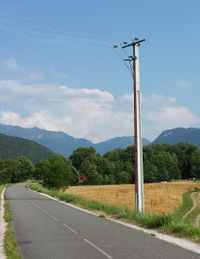RU:Tag:power=pole
 |
| Описание |
|---|
| Небольшая опора линии электропередач. Часто деревянная или бетонная мачта, предназначенная для поддержки линий электропередач. |
| Отображение в OSM Carto |
| Группа: энергетика |
| Используется на элементах |
| Подразумевает теги |
| Полезные сочетания |
|
| Смотри также |
| Статус: де-факто |
| Инструменты |
-
Деревянная опора-трезубец ЛЭП 132 кВ
Описание
Для небольших опор (столбов) воздушных линий электропередачи низкого и среднего напряжения (от 0,4 до 20 кВ включительно). ЛЭП 0,4 кВ (такие, как на третьей иллюстрации выше) часто встречаются в небольших городах и сельских населённых пунктах. В сельской местности ЛЭП среднего напряжения также часто представляют собой воздушные линии на небольших опорах (столбах). На концевых опорах воздушная линия переходит в подземную кабельную линию или подключается к трансформатору, который понижает напряжение до 0,4 кВ.
Не следует использовать этот тег для опор тех линий, которые не используются для передачи электрической энергии, например, телефонных (линий связи).
| Ключ | Значение | Описание | Обязательный? |
|---|---|---|---|
| power | pole |
Опора ЛЭП | да |
| pole:type | тип | Тип опоры (см. ниже возможные значения) | нет |
| ref | номер | Код или номер опоры | рекомендуемый |
| height | высота | Высота опоры | нет |
| operator | оператор | Название оператора опоры | рекомендуемый |
| structure | solid (сплошной), tubular (трубчатый) или lattice (решётчатый) | Тип конструкции опоры (по умолчанию solid) | нет |
| design | дизайн | Название общего дизайна опоры | нет |
| material | материал | Материал опоры | нет |
| Key | Value | Description | Picture |
|---|---|---|---|
| pole:type | suspension | A pole where the conductors or wires are mounted on pin insulators or suspension insulators, either on a cross-arm or the pole itself. This is the default type and does not need to be tagged, except on an angle pole (usually guyed guyed=yes), where an anchor pole is normally used.
|
  |
| anchor | A pole that uses strain insulators, either mounted on a cross-arm or on the pole itself. These are usually guyed for stability, except where the pole is mounted on a foundation, lies on a straight section of power line, or uses heavier construction, like a second pole in place of a guy or thicker material. |   | |
| termination | A pole using strain insulators on an end of a power line, like in a transformer (add transformer=* to the pole), substation, line-to-cable transition point (add location:transition=yes, or a short dead-end segment from a pole with a transformer or a turning location where the lines are connected on the air rather than on a pole. These poles are normally guyed (add guyed=yes) because of the tension from the terminating line.
|
  | |
| branch | A power line branches at this pole. If the branch line is a cable (except for overhead insulated cables), add location:transition=yes. The branch types may be as follows:
|
||
| Transposition | A pole where the conductors exchange positions to balance the impedance. For example, a three-phase line with phases A-B-C changes arrangement into B-C-A at a pole, or vice versa. | ||
| crossing | A taller pole used on locations where a line need higher height clearance, like where a line crosses an overpass. These are usually higher than the poles usually used. | ||
location:transition=*
|
yes
|
A power line transitions from line to cable, or vice versa, at this pole, or on other cases, on a concrete structure. This is not used when the cable is an overhead type (power=cable with location=overhead.
|
Возможные комбинации
power=pole(небольшая опора ЛЭП (столб)) +ref=*(номер опоры)
Для обозначения опоры, где воздушная ЛЭП подключена к подземному кабелю:
pole=transition
Если на опоре расположен понижающий трансформатор, добавить transformer=yes или transformer=distribution с тегами, описывающими трансформатор (voltage=*, rating=*, и т. д.).
Связанные термины: ‹ power pole ›
